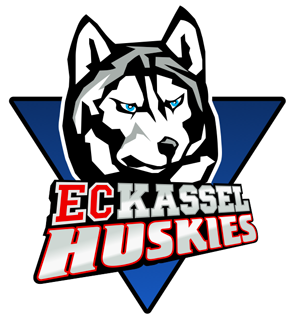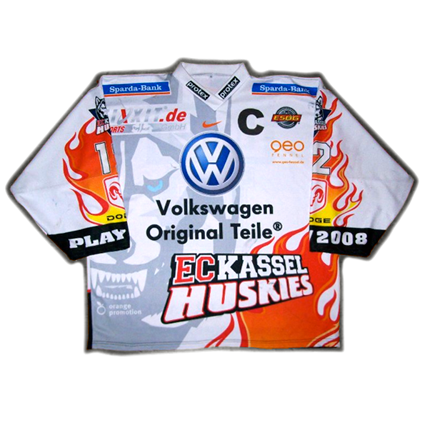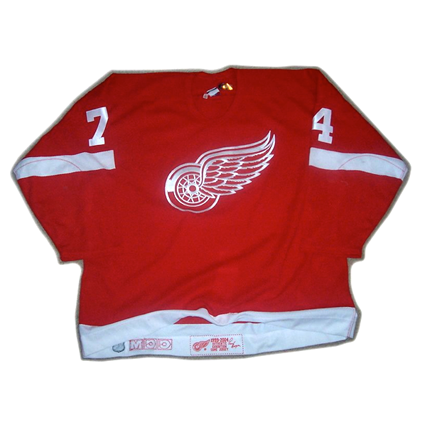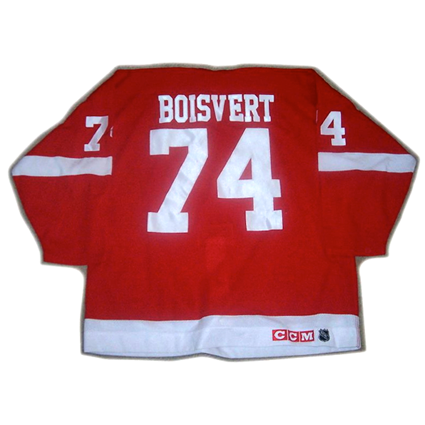Monday, July 12, 2010
2007-08 Kassel Huskies Hugo Boisvert Jersey
July by the Numbers takes a trip to Germany for jersey #12.
There are many ways in which the game of hockey is the same no matter where it's played, yet there are also many idiosyncratic differences in the ways things are done in different regions of the world.
The Kassel Huskies are a prime example of the many differences. The club was founded in 1977 as one of the founding members of the Deutsche Eishockey Liga (DEL). Many European leagues are run in the same format as the professional soccer leagues of Europe and employ a system of promotion and relegation, a concept foreign to the North American sports ladder system of minor leagues.
In North American sports, such as baseball and hockey, young up and coming players or veteran players not good enough to make the top pro teams are assigned to a "farm team" for further seasoning in hopes of making the big clubs. There is no penalty for any club that finishes with one of the worst records each season, and in fact they are rewarded for doing so with the first picks of the new crop of players eligible to be drafted. Being terrible for an extended period of time is essentially how the Pittsburgh Penguins and Chicago Blackhawks grew into Stanley Cup champions.
In Europe however, the teams who finish at the bottom of the standings are often penalized with a demotion (or "relegation") to the next lowest league each season, which works as a powerful incentive to consistently field the most competitive club possible, year after year.
Meanwhile, the teams playing in the lower divisions are rewarded for their success by being promoted up to the next highest league for the following season, which results in greater revenues due to factors such as larger contracts from media outlets and greater sponsorship revenues as a result of increased exposure at the higher levels.
The Kassel Huskies demonstrate how promotion and relegation can work in Europe. At one time members of the 2nd Division of the Bundesliga, they were included in the formation of the new DEL in 1994, which made them members of the top division of German hockey. The Huskies remained there through the reintroduction of relegation in 1999-00, including a runner-up finish in 1996-97, until the 2005-06 season in which they suffered "the drop" back down to the 2nd Division of the Bundesliga, where they remained for two seasons.
At the conclusion of the 2007-08 season, as 2nd Bundesliga playoff champions, they were promoted back to the top level DEL where they currently reside.
Hugo Boisvert of the Huskies is also representative of how European hockey, and Germany in particular, provides opportunities for professional players outside of North America. Boisvert attended Ohio State University from 1996-97 to 1998-99, leading the team in scoring in his last two seasons, which earned him a number of awards, including being named to the CCHA All-Rookie Team in 1997, the All-CCHA First Team and the First Team All-American in 1998 and the All-CCHA First Team and Second Team All-American, making him the only two-time All-American in Ohio State history, as well as being a finalist for the Hobey Baker Award in 1999.
Yet not one NHL club chose to spend a draft choice on Boisvert during his three years at Ohio State despite all the recognition, so following the completion of his college career, the native of St. Eustache, Quebec joined the Canadian National Team program for the 1999-00 season and then signed with the Orlando Solar Bears of the IHL for 2000-01. Following the demise of the Solar Bears he moved to the Grand Rapids Griffins of the AHL for three seasons. While there, he did earn an invite to the Detroit Red Wings training camp, but failed to crack their roster for even a single NHL contest.
Following his fourth season in the minors, Boisvert made the decision to relocate to Germany, joining Duisburg EV of the German second division. The move was successful for both parties, as Boisvert led the Foxes in scoring and the team won promotion to the DEL for the following season. Following another season with EV Duisburg, in which Boisvert was named team captain, he moved to the Kassel Huskies, the very same team his EV Duisburg club defeated in a playoff to relegate!
While the Huskies finished first in the 2nd Bundesliga in 2006-07, they were defeated in the playoffs to determine which club would be promoted up to the DEL. 2007-08 was a different story, as the dominant Huskies again finished first in the league, 27 points ahead of the next closest team, and marched through the playoffs to return to the DEL for 2008-09 for the second time in Boisvert's German career.
While other European leagues have tighter restrictions on the number of foreign players allowed on each team's roster to preserve opportunities for homegrown talent, the limit on the number of foreign players in the DEL is more liberal and is currently set at ten. In comparison, teams in the primarily Russian KHL are limited to signing five foreign players with no more than four skating in a game.
Since moving to Germany, Boisvert has now scored 110 goals and 244 points in six seasons and captained both clubs he has played for. His story is similar to other players we have written about whose NHL careers came to a close, but continued to play for years in Germany while earning much respect as captains of their clubs.
Another one of the main differences between the way things are done in North American professional hockey and Europe is in terms of the jerseys, particularly in how the jerseys are made and the approach to sponsorships.
While in North America the vast majority of jerseys at the NHL and AHL level have their stripes sewn into (or onto) the jerseys, keeping them frankly rather basic in design, many European jerseys employ the art of dye-sublimation, which starts with a blank white jersey and then has all the design elements printed onto the jersey, which allows for all manner of wild looks created by a graphic designer with no real limitation but their imagination, which can sometimes run amok. Then add on the excessive sponsorship logos common in Europe, and you can sometimes barely tell what the actual name of the team is.
Today's featured jersey is a 2007-08 Kassel Huskies Hugo Boisvert jersey as worn during the 2007-08 playoffs which features no less than 17 different sponsorship logos. Additionally, the jersey sports a collar of a style not found on North American jerseys. Hidden among the logos on the front is a captain's "C" and a screened back, full-bleed husky's head in an intimidating snarl. There are also flames shooting up the arms and across the torso, something you would never find on an NHL jersey where even a diagonal stripe is viewed as an oddity.
The jersey also has the European layout on the back, where one of the team's sponsors takes the prime real estate at the top of the back, while the players name is relegated to a position below his number.
Bonus Jersey: Today's Bonus jersey is a 2003-04 Detroit Red Wings Hugo Boisvert jersey. This jersey has the unusual block letters with serifs on the back, rather than the normal, vertically arched letters normally found on Red Wings jerseys. The reason for this is due to this jersey being worn in during pre-season games during training camp, when the Red Wings traditionally use the less complicated lettering style, saving their vertically arched lettering for the regular season.
Our video section today shows Hugo Boisvert scoring for the Kassel Huskies and sending their fans into something near rapture.
In this video of game action between Eisbaren Berlin and the Kassel Huskies, note the many sponsorship logos on the ice, including all five face-off circles as well as the area behind the goal lines as well as at center ice, which is now common in the NHL.
Labels:
Boisvert Hugo,
DEL,
Kassel Huskies
Subscribe to:
Post Comments (Atom)
















Wow, just been browsing around the net for a bit, so I land here at this great blog, I begin to read, very nicely written, scrolling down and almost fall off my chair as I see a jersey that is part of my very own collection. Cool!
ReplyDeleteThere is a story behind this particular jersey design: Kassel had these designed especially for the play-offs in 08, this is the road jersey, the home is basically the same, only that it's black. Comes first round of play-off and Kassel have to face ETC Crimmitschau, who very unexpectedly made the POs. Kassel loses twice during the series (inkl a 3-7 blow-out) in Crimmitschau and after that they decide to dump the PO-jerseys and return to the regular season design. So these were actually only worn in two games each (home and road).
Cheers from Germany,
Uffel
Thank you for sharing the details behind your jersey and we're glad to hear you were pleased to see your jersey featured here. It's a great jersey and now has an even better story to go with it.
ReplyDelete